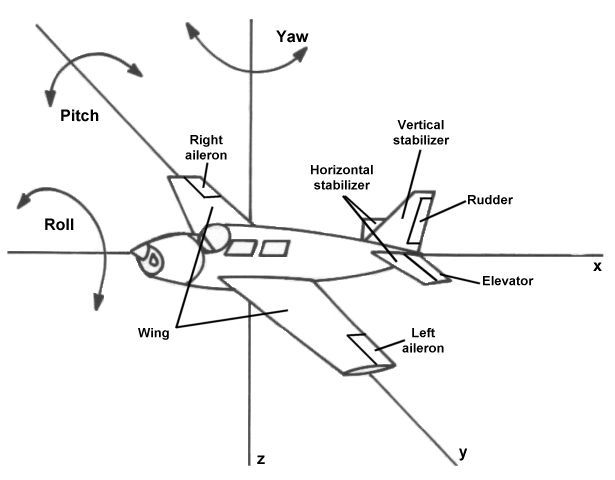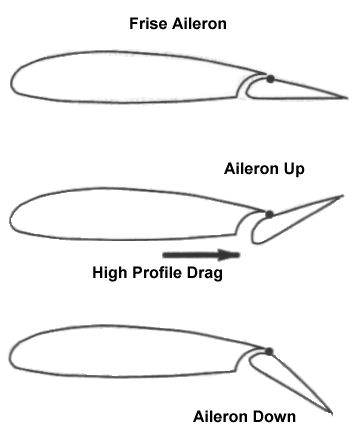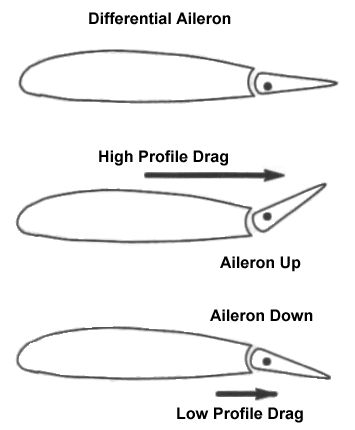|
||||||||||
|
|
||||||||||
|
||||||||||
|
|
||||||||||

First, the aircraft nose can rotate up and down about the y-axis, a motion known as pitch. Pitch control is typically accomplished using an elevator on the horizontal tail. Second, the wingtips can rotate up and down about the x-axis, a motion known as roll. Roll control is usually provided using ailerons located at each wingtip. Finally, the nose can rotate left and right about the z-axis, a motion known as yaw. Yaw control is most often accomplished using a rudder located on the vertical tail.

However, the effect of one control surface is not always limited to just pitch, roll, or yaw alone. When the deflection of one control surface affects more than one of these orientations, we say that the orientations are coupled. The most important of these coupled interactions is adverse yaw. To better understand the concept, let's study a picture of what happens when the pilot deflects the ailerons to roll the aircraft.

As you can see, the aircraft rolls because one aileron is deflected downward while the other is deflected upward. Lift increases on the wing with the downward-deflected aileron because the deflection effectively increases the camber of that portion of the wing. Conversely, lift decreases on the wing with the upward-deflected aileron since the camber is decreased. The result of this difference in lift is that the wing with more lift rolls upward to create the desired rolling motion.
Unfortunately, drag is also affected by this aileron deflection. More specifically, two types of drag, called induced drag and profile drag, are increased when ailerons are deployed. Induced drag is a form of drag that is induced by any surface that generates lift. The more lift a surface produces the more induced drag it will cause (for a given wingspan and wing area). Thus, the wing on which the aileron is deflected downward to generate more lift also experiences more induced drag than the other wing. Profile drag includes all other forms of drag generated by the wing, primarily skin friction and pressure drag. This profile drag increases on both wings when the ailerons are deflected, but the increase is equal when the ailerons are deflected by the same amount. However, the induced drag on each side is not equal, and a larger total drag force exists on the wing with the down aileron. This difference in drag creates a yawing motion in the opposite direction of the roll. Since the yaw motion partially counteracts the desired roll motion, we call this effect adverse yaw.
We can correct for this effect in several ways, the most important methods being:

Frise ailerons accomplish this differential profile drag by maintaining a smooth contour between the upper surfaces of the wing and aileron, causing very little drag, while the bottom surface of the aileron juts downward to create a large increase in profile drag. Although this approach is simple and does provide some relief, the performance of Frise ailerons is very dependent on operating conditions. For this reason, such ailerons are often only partially effective at overcoming adverse yaw.

As in the case of Frise aileron, this differential profile drag produces a yawing motion that at least partially offsets the adverse yaw, but the effect is limited.

When used in coordination with ailerons, a spoiler can be used to reduce the lift and increase the profile drag on the wing with the up aileron. As a result, the wing with the down aileron experiences a large increase in lift and a small increase in drag while the wing with the up aileron experiences a large decrease in lift and a large increase in drag. These effects combine to create the desired roll motion and a complimenting yaw motion that is called proverse yaw.
Related Topics:
Read More Articles:


|
Aircraft | Design | Ask Us | Shop | Search |

|
|
| About Us | Contact Us | Copyright © 1997- | |||
|
|
|||